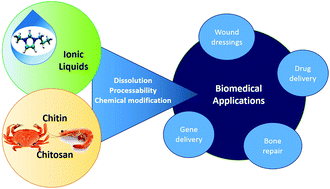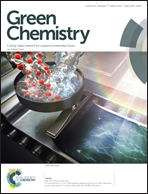Ionic liquids in the processing and chemical modification of chitin and chitosan for biomedical applications
Abstract
Ionic liquids (ILs) have huge potential to provide advances in many areas such as energy, pharmaceutical formulations, biomedical sciences, and technology. In the biomedical field, ILs have been intensively investigated for use as potential solvents for some polysaccharides to overcome their lack of solubility and processability. This review focuses on the application of ILs as solvents and reaction media to develop chitin- and chitosan-based materials. Dissolution of chitin and chitosan in ILs such as 1-butyl-imidazolium acetate (BMIMAc) and 1-ethyl-3-methylimidazolium chloride (BMIMCl) has been used to create materials including sponges, films, microspheres, and aerogels. Moreover, ILs have a key role in chemical reactions, hydrolysis, acetylation, deacetylation and graft copolymerization of chitin/chitosan, promoting homogeneous media and thus enhancing the efficiency of the reactions. The resulting materials can be applied in wound healing, tissue regeneration, gene delivery, and drug delivery systems. In particular, they have been designed to support tissue regeneration and to act as hemostatic and antibacterial agents and/or delivery vehicles for drugs. Although IL platforms offer new ways for the sustainable processing of chitin and chitosan to a variety of matrices, studies involving their in vivo biocompatibility are scarce, and this has prevented these advances being turned into clinical solutions.



 Please wait while we load your content...
Please wait while we load your content...